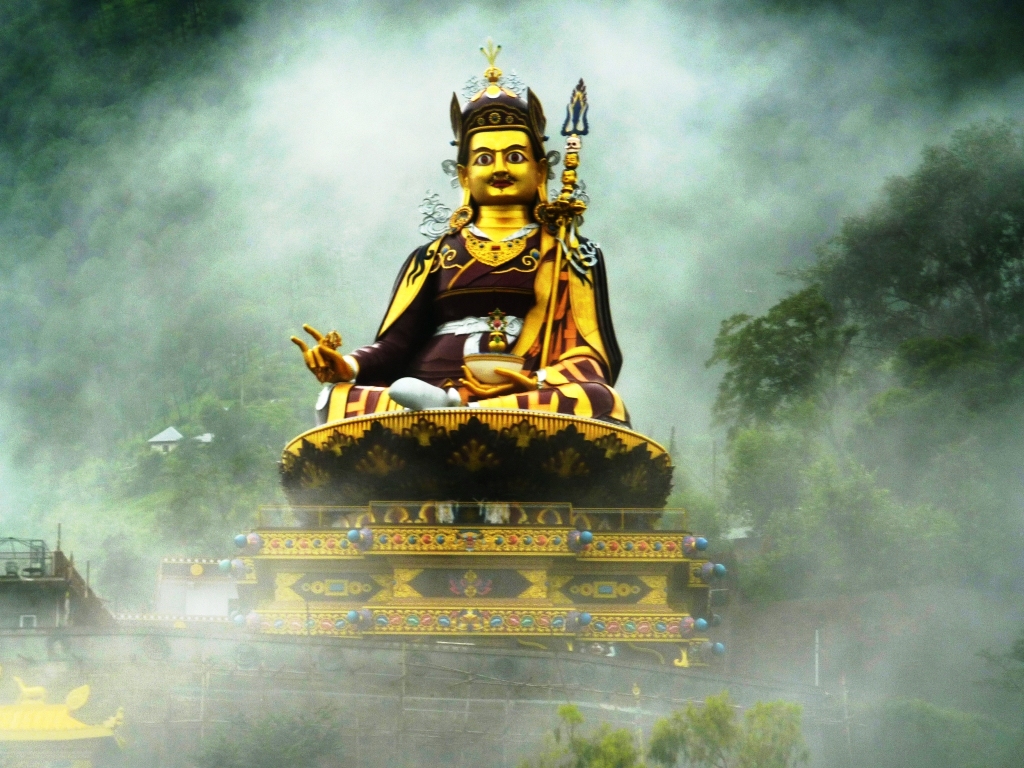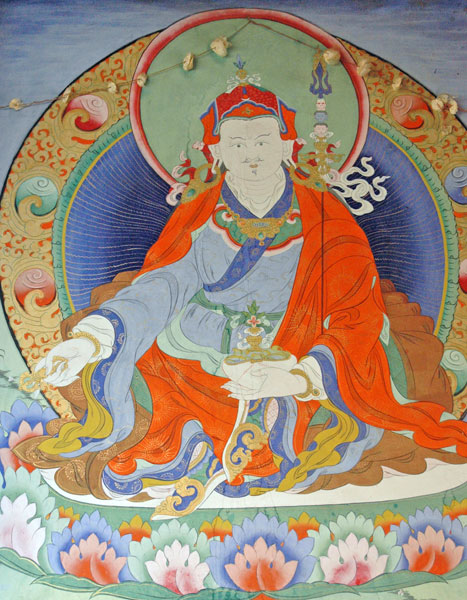|
Paro, Bhutan
Paro ( dz, སྤ་རོ་) is a town and seat of Paro District, in the Paro Valley of Bhutan. It is a historic town with many sacred sites and historical buildings scattered throughout the area. It is also home to Paro International Airport, Bhutan's sole international airport. Paro International Airport is served by Drukair. Architecture The main street has many examples of traditionally decorated buildings. The Dungtse Lhakhang (a 15th-century temple) and the Ugyen Perli Palace are near the new bridge. Members of royal family lodge in the palace when in Paro. Nearby is the old bridge and the Rinpung Dzong. Notable hotels include the Olathang Hotel built in an ornate style. About outside Paro is the famous Paro Taktsang (Tiger's Nest) Buddhist monastery and hermitage. Some Bhutanese believe that Padmasambhava (Guru Rinpoche) flew on the back of a tigress to this location from Tibet Tibet (; ''Böd''; ) is a region in East Asia, covering much of the Tibet ... [...More Info...] [...Related Items...] OR: [Wikipedia] [Google] [Baidu] |
National Geospatial Intelligence Agency
The National Geospatial-Intelligence Agency (NGA) is a combat support agency within the United States Department of Defense whose primary mission is collecting, analyzing, and distributing geospatial intelligence (GEOINT) in support of national security. Initially known as the National Imagery and Mapping Agency (NIMA) from 1996 to 2003, it is a member of the United States Intelligence Community. NGA headquarters, also known as NGA Campus East or NCE, is located at Fort Belvoir North Area in Springfield, Virginia. The agency also operates major facilities in the St. Louis, Missouri area (referred to as NGA Campus West or NCW), as well as support and liaison offices worldwide. The NGA headquarters, at , is the third-largest government building in the Washington metropolitan area after The Pentagon and the Ronald Reagan Building. In addition to using GEOINT for U.S. military and intelligence efforts, NGA provides assistance during natural and man-made disasters, aids in securi ... [...More Info...] [...Related Items...] OR: [Wikipedia] [Google] [Baidu] |
Kyichu Lhakhang
Kyichu Lhakhang, (also known as Kyerchu Temple or Lho Kyerchu) is an important Himalayan Buddhist temple situated in Lango Gewog of Paro District in Bhutan. History The Jowo Temple of Kyichu is one of the oldest temples in Bhutan, originally built in the 7th century by the Tibetan Emperor Songtsen Gampo. It is considered to be one of the 108 border taming temples he built. In the 8th century the temple was visited by Padmasambhava and it is believed he concealed many spiritual treasures here. Je Khenpo Sherab Gyaltshen wrote that during the 12th century the temple was looked after by the Lhapa Kagyu tradition and that during the 13th century it was handed over to a descendant of Phajo Drugom Zhigpo's son Nyima. In his ''The Nyingma School of Tibetan Buddhism: Its Fundamentals and History'', Jigdral Yeshe Dorje (2nd Dudjom Rinpoche) records that the Jowo Temple of Kyichu could not be seen and that Pema Lingpa (1450-1521) uncovered the temple and restored it as it was before. ... [...More Info...] [...Related Items...] OR: [Wikipedia] [Google] [Baidu] |
Oceanic Climate
An oceanic climate, also known as a marine climate, is the humid temperate climate sub-type in Köppen classification ''Cfb'', typical of west coasts in higher middle latitudes of continents, generally featuring cool summers and mild winters (for their latitude), with a relatively narrow annual temperature range and few extremes of temperature. Oceanic climates can be found in both hemispheres generally between 45 and 63 latitude, most notably in northwestern Europe, northwestern America, as well as New Zealand. Precipitation Locations with oceanic climates tend to feature frequent cloudy conditions with precipitation, low hanging clouds, and frequent fronts and storms. Thunderstorms are normally few, since strong daytime heating and hot and cold air masses meet infrequently in the region. In most areas with an oceanic climate, precipitation comes in the form of rain for the majority of the year. However, some areas with this climate see some snowfall annually during winter. ... [...More Info...] [...Related Items...] OR: [Wikipedia] [Google] [Baidu] |
Tibet
Tibet (; ''Böd''; ) is a region in East Asia, covering much of the Tibetan Plateau and spanning about . It is the traditional homeland of the Tibetan people. Also resident on the plateau are some other ethnic groups such as Monpa people, Monpa, Tamang people, Tamang, Qiang people, Qiang, Sherpa people, Sherpa and Lhoba peoples and now also considerable numbers of Han Chinese and Hui people, Hui settlers. Since Annexation of Tibet by the People's Republic of China, 1951, the entire plateau has been under the administration of the People's Republic of China, a major portion in the Tibet Autonomous Region, and other portions in the Qinghai and Sichuan provinces. Tibet is the highest region on Earth, with an average elevation of . Located in the Himalayas, the highest elevation in Tibet is Mount Everest, Earth's highest mountain, rising 8,848.86 m (29,032 ft) above sea level. The Tibetan Empire emerged in the 7th century. At its height in the 9th century, the Tibet ... [...More Info...] [...Related Items...] OR: [Wikipedia] [Google] [Baidu] |
Rinpoche
Rinpoche, also spelled Rimboche and Rinboku (), is an honorific term used in the Tibetan language. It literally means "precious one", and may refer to a person, place, or thing—like the words "gem" or "jewel" (Sanskrit: '' Ratna''). The word consists of ''rin'' (value), ''po'' (nominalizing suffix) and ''chen'' (big). The word is used in the context of Tibetan Buddhism as a way of showing respect when addressing those recognized as reincarnated, older, respected, notable, learned and/or an accomplished Lamas or teachers of the Dharma. It is also used as an honorific for abbots of Buddhist monasteries. See also * Rinpoches, a partial list of a few spiritual teachers of past and present commonly addressed as ''Rinpoche''. *Tulku, someone who is recognized as the rebirth of a previous practitioner of Tibetan Buddhism. *Mount Kailash Mount Kailash (also Kailasa; ''Kangrinboqê'' or ''Gang Rinpoche''; Tibetan: གངས་རིན་པོ་ཆེ; ; sa, कैल� ... [...More Info...] [...Related Items...] OR: [Wikipedia] [Google] [Baidu] |
Padmasambhava
Padmasambhava ("Born from a Lotus"), also known as Guru Rinpoche (Precious Guru) and the Lotus from Oḍḍiyāna, was a tantric Buddhist Vajra master from India who may have taught Vajrayana in Tibet (circa 8th – 9th centuries)... According to some early Tibetan sources like the ''Testament of Ba'', he came to Tibet in the 8th century and helped construct Samye Monastery, the first Buddhist monastery in Tibet. However, little is known about the actual historical figure other than his ties to Vajrayana and Indian Buddhism. Padmasambhava later came to be viewed as a central figure in the transmission of Buddhism to Tibet. Starting from around the 12th century, hagiographies concerning Padmasambhava were written. These works expanded the profile and activities of Padmasambhava, now seen as taming all the Tibetan spirits and gods, and concealing various secret texts ('' terma'') for future tertöns. Nyangral Nyima Özer (1124–1192) was the author of the ''Zangling-ma'' (Jew ... [...More Info...] [...Related Items...] OR: [Wikipedia] [Google] [Baidu] |
Paro Taktsang
Paro Taktsang ( dz, སྤ་གྲོ་སྟག་ཚང་, also known as the Taktsang Palphug Monastery and the Tiger's Nest), is a sacred Vajrayana Himalayan Buddhist site located in the cliffside of the upper Paro valley in Bhutan. It is one of thirteen Tiger's Nest caves in historical Tibet in which Padmasambhava practiced and taught Vajrayana.Khenchen Palden Sherab Rinpoche, ''The Eight Manifestations of Guru Rinpoche'', (May 1992), https://turtlehill.org A later monastery complex was built in 1692, around the ''Taktsang Senge Samdup'' cave, where Guru Padmasambhava meditated and practiced with students including Yeshe Tsogyal before departing the kingdom of Tibet in the early 9th century. Padmasambhava is credited with introducing Vajrayana Buddhism to Bhutan, which was then part of Tibet, and is the tutelary deity of the country. Today, Paro Taktsang is the best known of the thirteen ''taktsang'' or "tiger lair" caves in which he and his students meditated. The shri ... [...More Info...] [...Related Items...] OR: [Wikipedia] [Google] [Baidu] |
Rinpung Dzong
Rinpung Dzong, sometimes referred to as Paro Dzong, is a large dzong - Buddhist monastery and fortress - of the Drukpa Lineage of the Kagyu school in Paro District, Bhutan. It houses the district Monastic Body as well as government administrative offices of Paro Dzongkhag. It is listed as a tentative site in Bhutan's Tentative List for UNESCO inclusion. History In the 15th century local people offered the crag of Hungrel at Paro to Lama Drung Drung Gyal, a descendant of Pajo Drugom Zhigpo. Drung Drung Gyal built a small temple there and later a five storied Dzong or fortress which was known as Hungrel Dzong. In the 17th century, his descendants, the lords of Hungrel, offered this fortress to the Drukpa hierarch, Ngawang Namgyal, the Zhabdrung Rinpoche, in recognition of his religious and temporal authority. In 1644 the Zhabdrung dismantled the existing dzong and laid the foundations of a new dzong. In 1646 the dzong was reconsecrated and established as the administrative and m ... [...More Info...] [...Related Items...] OR: [Wikipedia] [Google] [Baidu] |
Drukair
Drukair Corporation Limited ( dz, འབྲུག་མཁའ་འགྲུལ་ལས་འཛིན།), operating as Drukair — Royal Bhutan Airlines, is the flag carrier of the Kingdom of Bhutan, headquartered in the western dzongkhag of Paro. Founded in 1981, ten years after Druk Gyalpo Jigme Dorji Wangchuck gradually began to open up the kingdom from self-imposed isolation, and seven years after welcoming its first foreign visitors, the airline commenced operations in 1983 with flights from Kolkata to Paro utilising Dornier 228 aircraft. A switch to BAe 146-100 equipment occurred in November 1988, and, in order to meet increased demand, those aircraft were replaced in 2004 with five Airbus A319s. Drukair operates a modest scheduled flight network within the South Asian and Southeast Asian region from its base at Paro Airport and currently serves thirteen destinations in six countries. The airline also owns a small fleet of four Airbus A320 family jets - t ... [...More Info...] [...Related Items...] OR: [Wikipedia] [Google] [Baidu] |
Paro International Airport
Paro International Airport ( dz, སྤ་རོ་གནམ་ཐང༌།, paro gnam thang) is the sole international airport of the four airports in Bhutan. It is from Paro in a deep valley on the bank of the river Paro Chhu. With surrounding peaks as high as , it is considered one of the world's most challenging airports, and only eight pilots are certified to land at the airport. Flights to and from Paro are allowed under visual meteorological conditions only and are restricted to daylight hours from sunrise to sunset. Paro airport was the only airport in Bhutan until 2011. Paro Airport is accessible by road, from Paro city, and from Thimphu by Paro-Thimphu road. History In 1968, the Indian Border Roads Organisation built an airstrip in the Paro valley, which was initially used for on-call helicopter operations by the Indian Armed Forces on behalf of the Royal Government of Bhutan. Bhutan's first airline, Drukair, was established by Royal Charter on 5 April ... [...More Info...] [...Related Items...] OR: [Wikipedia] [Google] [Baidu] |





